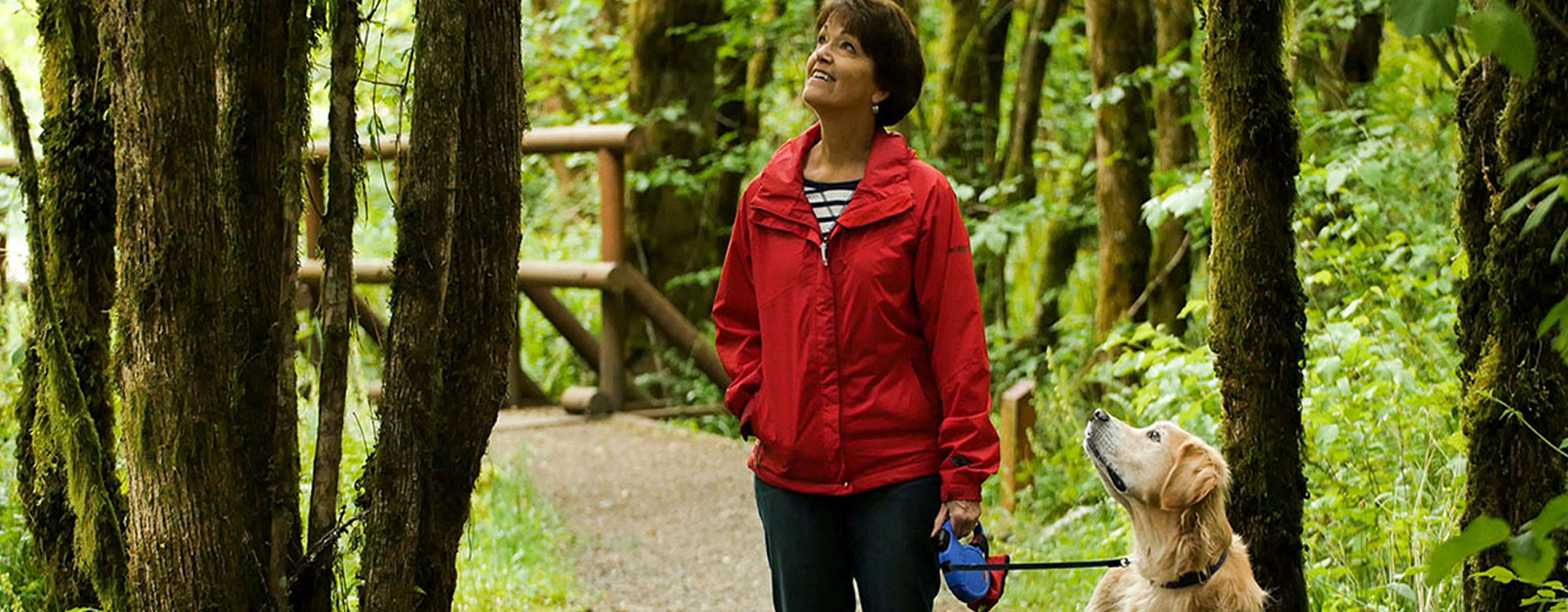Good trail etiquette means being a good neighbor – ensuring that everyone feels respected, enjoys their time in the forest, and stays safe. Our mixed use trails are designed to support foot traffic, mountain biking, and horseback riding. Motorized vehicles are not allowed on Forest roads or trails, except for administrative purposes. Motor vehicles can include cars, trucks, motorcycles, e-bikes, hover boards, Segways, etc. Motorized wheelchairs are permitted.
General Trail Etiquette Guidelines
- Share friendly greetings with fellow trail users
- Stick to the right of the trail and pass on the left
- If using headphones, keep the volume down or remove one so you can hear people approaching from behind
- Do not disturb wildlife or active research and teaching sites
- When safe to do so, climb over obstacles like fallen trees rather than traveling around them (and report fallen trees to Forest Staff)
- Stay on the trail: do not cut switchbacks and travel single file unless the trail is wide enough so neither person walks on the trail edge
- Always carry out trash, dog waste and any belongings

Wet Weather:
Trails are built and maintained by volunteers. Protect their efforts by traveling carefully during the wet season.
Use Dirt Trails, Not Muddy Trails:
- Wet and muddy trails are more at risk of damage than dry trails. This is especially important for natural surface trails. It's too muddy when:
- Your shoe, tire or hoof leaves a track in the mud: Check out this cool graphic of muddy tracks
- There's standing water on the trail
Protect trails:
- Use roads and graveled trails until natural surface trails dry out
- If you find yourself on a wet section of trail, travel through puddles not around them to prevent trail widening
- Check seasonal closures to make sure the trail is open to your type of use before heading out.
Mixed Use Trails:
Hiking, jogging, mountain biking, and horse-back riding on the OSU Research Forests are popular community pastimes with lots of awesome benefits! While you’re out and about, here are a few things to keep in mind:
- Follow the yield triangle (see above)
- Let people know when you are going to pass them with a friendly greeting or a bike bell
- Stay on authorized roads and trails designated for your type of use
- Travel at safe and reasonable speeds and slow down on blind curves; be able to stop in half the distance you can see
- When encountering someone on horseback, announce your presence, stand on the downhill side of the trail and ask the rider how to proceed
- When traveling downhill, expect to encounter uphill users and be ready to yield on one side of the trail.
- Dogs are required to be on leash or under voice control.
- Your dog is allowed off-leash as long as your dog comes consistently when called and you are willing to prevent your pup from approaching other dogs when appropriate.
- Your dog needs to be on-leash if your dog does not consistently come when called, or if your dog interferes with the enjoyment or safety of other dogs or humans or impacts forest resources (such as wildlife, research, etc)
Dogs on the OSU Research Forests:
- Most owners are happy to hold onto their dogs or put them on a leash while you pass by, especially when asked with a smile.
- Reasons for not wanting to interact with dogs may include allergies, poison oak, mud, personal boundaries, or even traumatic past experiences with dogs. Prevent your dog from approaching others unless invited.
- Keeping your dog in sight at all times helps to protect them from injury in the forest or attack by another animal.
- Unleashed dogs approaching leashed dogs can potentially create a dangerous psychological dynamic for dogs, leading to unpredictable behavior. Dogs may be leashed for multiple reasons, including grumpy behavior or to protect their dog from others. Check with the owner of a leashed dog before allowing your dog to approach.
- Be sure to check with the owner of any dog before letting a child approach.
- Aggressive dogs (dogs who pose a threat to other dogs or people) are not allowed on the Forest, even if on-leash.
- Voice control means that your dog:
- Stays within sight of you at all times, regardless of distractions, and
- Stays a respectful distance away from others, and
- Comes to you right away when you call, every time
- Consider recall training from a local dog trainer to help your dog become an off-leash dog!
- To report an incident relating to a dog on the OSU Research Forests, contact Benton County Animal Control at (541)766-6858.
